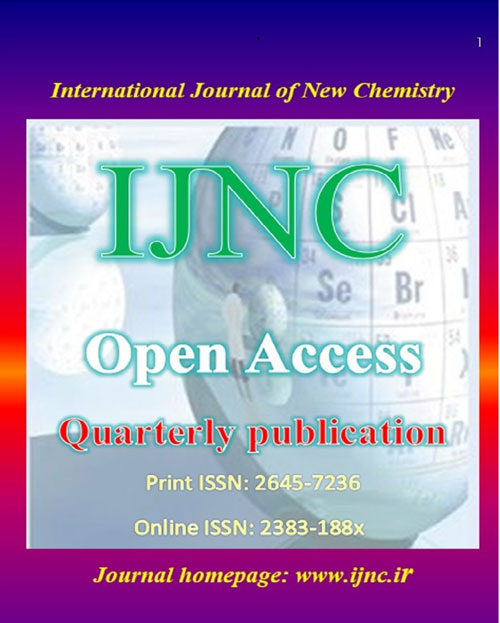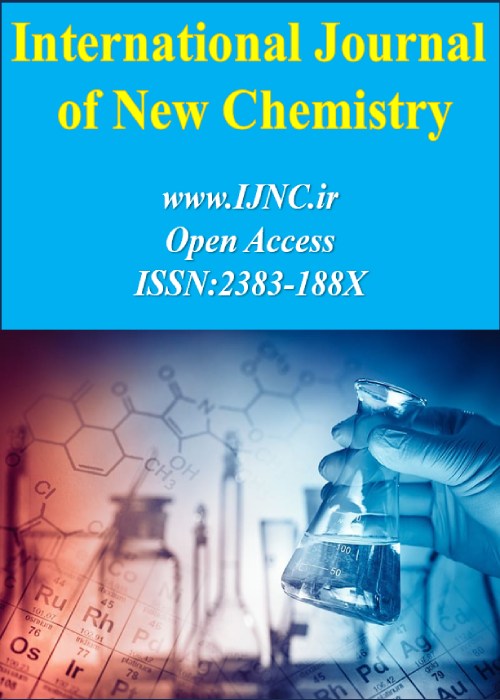فهرست مطالب

International Journal of new Chemistry
Volume:9 Issue: 3, Summer 2022
- تاریخ انتشار: 1401/01/12
- تعداد عناوین: 6
-
Pages 1-7IntroductionIn the present study, the quality and quantity of heart surgeries in cardiac abnormalities, congenital malformations and resulting mortality in one of the important centers of cardiovascular surgery have been studied.Material and MethodsIn this retrospective cohort study, the clinical records of 100 children who underwent surgery in Shahid Madani Hospital (Tabriz University of Medical Sciences) during 2010 to 2021 and were admitted to the intensive care unit were evaluated for surgical results.ResultsMost deaths in the first ten years were due to complete correction of follow-up tetralogy, followed by repair and replacement of mitral valve, and in the second ten years, most deaths were due to systemic pulmonary shunting, followed by complete correction of follow-up tetralogy. Overall mortality in the second ten years is about 2% lower than in the first ten years.ConclusionThis statistic is related to the total population of patients with congenital heart defects in this country and in our country there are no accurate statistics on the total number of deaths from congenital heart defects and the statistics of this study are related to patients who underwent surgery during 10 The year is in this center. In the end, it is hoped that in the near future we will see surgery to completely correct congenital heart defects at ideal ages along with planning to reduce patient mortality in the countryKeywords: pediatric heart surgeries, Intensive care unit, results
-
Pages 8-15Introduction
ANH is most commonly used in surgeries that involve the loss of large amounts of blood, most commonly in heart surgeries with or without extracorporeal circulation, aneurysm surgery, orthopedic surgery (thigh and knee), vascular surgery, and Thoracic surgery, urological surgery and general surgery are used. The rate of bleeding is more than 10% to 15% of the patient's intravascular volume.
Material and MethodsThis study is a retrospective study that was conducted during 2019 with the participation of patients candidates for cardiovascular surgery at Tabriz University of Medical Sciences who needed blood transfusions. Blood transfusion method was evaluated by ANH method and the results were reported.
ResultsIn 86.4% patients had coronary artery bypass graft, in 6.6% patients had a heart valve replacement including aorta and mitral. In 0.9%) patients, mitral and aortic valve replacement was performed simultaneously (MVR+AVR) and in 3.2% patients, coronary artery transplantation was observed with mitral and aortic valve replacement. In 2.3% patients with congenital heart abnormalities and in 0.6% patients with Bental surgery in ascending aortic aneurysm (aortic valve replacement, Aortic root, ascending aorta, and repositioning of coronary arteries into grafts were performed.
ConclusionAccording to the present study, none of the patients showed cardiac arrhythmia or hemodynamic instability during blood sampling and up to half an hour after it, so autologous ANH transfusion for cardiac surgery patients (coronary artery bypass graft and valve replacement) in this Research was a safe way.
Keywords: autologous blood transfusion, Cardiac surgery, ANH method -
Pages 16-24IntroductionAlthough postoperative fluid therapy has been mentioned as one of the primary treatments to improve the symptoms of this type of headache, but so far no study has been done on fluid therapy before spinal anesthesia. Therefore, the aim of this study was to determine the effect of fluid therapy before spinal anesthesia on the incidence, duration and severity of postoperative postural headache in women with elective cesarean section.Material and MethodsThis study was performed as a clinical experiment with the participation of 150 women candidates for elective cesarean section in Al-Zahra Hospital (Tabriz University of Medical Sciences). Half an hour before the onset of spinal anesthesia, patients were given 500 cc of serum, after which the incidence of anesthesia-induced headache was compared between participants.ResultsThe frequency of headache in the intervention group was 2 (2.7%) and in the control group was 12 (16%) and the results of chi-square test showed that the incidence of headache was significantly lower in the intervention group than the control group (0.005 = p). In order to evaluate other indicators of headache including severity, duration, starting day, number of painkillers used and the need for painkillers in the two groups, first people with headache were selected and their normality in the two groups was confirmed by Kolmogorov-Smirnov test.ConclusionAdministration of intravenous serum during fasting to expectant mothers who are candidates for elective cesarean section can reduce the incidence of postural spinal anesthesia in the days following cesarean section.Keywords: fluid therapy, Cesarean Section, spinal anesthesia, Headache
-
Pages 25-40Background
Smoking increases the risk of cardiovascular disease (CVD) and significantly affects the severity and pattern of coronary artery disease (CAD). Moreover, tobacco smoking increases the risk of CVD and finally will cause morbidity and mortality. It has been proved that the increment of habitual consumption of cigarettes per day up to 20 increases the risk of myocardial infarction by about three times greater than in nonsmokers.
ObjectiveIn this study, we are trying to review the effect of cigarettes and their nicotine content on heart health and the heart disease which are induced by smoking.
MethodA comprehensive literature search was performed in PubMed, EMBASE, Cochrane Library, PubMed Central (PMC), UpToDate databases, and Google Scholar databases from 2012 till Feb 2020. In this regard, pre-decided keywords were used and specific inclusion/exclusion criteria were considered to achieve more accurate and related papers. Data were extracted from all the included studies through a precise review of the articles.
ConclusionIn this study, the evidence regarding the effect of smoking on coronary heart disease (CHD) and the severity and pattern of CVD are reviewed. Based on our study, smoking increases the risk of nearly all CVD subtypes such as acute myocardial infarction (AMI), cerebrovascular disease, and heart failure. Smoking has some relative risks that their fatal and non-fatal outcomes are similar. The risk of heart diseases related to smoking will decrease significantly after quitting smoking.
Keywords: Smoking, Nicotine, Heart, Coronary Heart Disease, cardiovascular disease -
Pages 42-49IntroductionIn addition to clinical evaluation and radiological studies, a number of factors seem to be able to be used independently in determining the prognosis and fate of trauma patients. Among these factors, metabolic acidosis and CRP seem to be helpful in the first two days of admission, and considering the large number of trauma patients referred to Imam Khomeini Hospital and the measurability of these factors in these patients, it seems that the effect is evaluated. And the accuracy of measuring these factors in the care and treatment of these patients is valuable.Material and MethodsDuring this study, demographic characteristics (age, sex), underlying diseases, organ failure, duration of mechanical ventilation, duration of hospitalization in the intensive care unit and hospital, frequency of mortality, CRP and trauma score were included in the checklist prepared by Was realized and statistically examined after completion.ResultsIn this study, we also investigated the predictive value of CRP in patients with blunt trauma admitted to the intensive care unit. The results showed that CRP levels in the age group over 90 years are significantly different from other age groups and the mean CRP level in this age group is higher than other age groups.ConclusionIn this study, there was a significant difference between the mean duration of mechanical ventilation, length of hospital stay, patient outcome and mean trauma score in patients with high CRP levels.Keywords: CRP, trauma, Outcome, Clinical Evaluation
-
Pages 50-57IntroductionPatients at risk for acute renal failure include the elderly, those with diabetes mellitus, heart failure, liver failure, chronic kidney disease, hypotension, and bloodstream infections. The aim of this study was to investigate the underlying factors of acute lung failure in trauma patients admitted to the ICU of Imam Khomeini Hospital in Urmia.Material and MethodsPatients were classified into three categories: perrenal, renal and postrenal. The differentiation of these three categories was based on the diagnosis recorded in the file and the summary of the patient''s case. Incomplete records and patients with a history of dialysis, ESRD, and GN patients who do not meet the criteria for acute renal failure were excluded.ResultsOut of 10 patients with acute kidney injury, there was no case of disease and out of 110 patients without acute kidney injury, 18 (16.4%) had the disease. According to Fisher Exact test, there was no significant relationship between comorbidity and acute kidney injury (P = 0.18).ConclusionOlder patients with AKI have more severe disease and sepsis. The mortality rate in patients with AKI is higher than patients without AKI, especially in patients with oliguria. Data analysis showed that age, SAPS II, heart failure, liver cirrhosis, body fluid balance and mechanical ventilation were independently associated with 60-day mortality in these patients.Keywords: Acute Renal Failure. ICU, trauma, AKI


